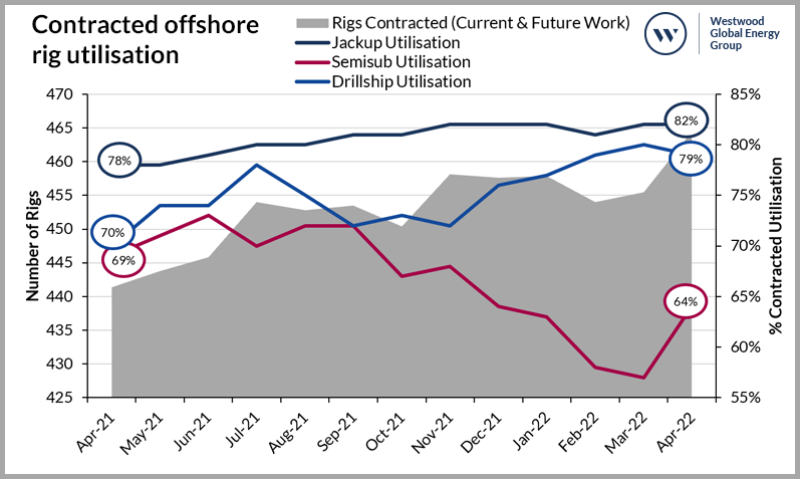Not only are offshore rigs becoming more scarce, the industry is underestimating its dwindling supply of available units.
This is according to a new report from Westwood Global Energy Group which said, “It appears the true extent of this tightening market is still not always being accurately represented across the industry.”
The energy consultancy notes that all three segments of the business—jackups, semisubmersibles, and drillships—show a contracted utilization rate below 85%. The figure represents an important industry threshold since it traditionally marks the minimum level required for dayrates to head north and for cold-stacked units to be called back into service.
However, this shift appears to be well underway per data from Westwood.
In its estimates, Westwood is figuring in the number of formerly idle rigs that are now in the process of being reactivated along with those undergoing work quayside to be prepared for future drilling projects.
In this context, the utilization rate for jackup rigs rises from 82% to 92%. Similarly, drillship utilization levels are up from 79% to 92%.
When looking beyond ongoing contracted work, Westwood said these figures reflect “a nearly sold-out market” for jackups and drillships.
Semisubmersibles are trailing with a utilization rate of 64% based on current contracts. Taking upcoming projects into account, though, Westwood said the real utilization rate is closer to 82%.
“Break this down further by region or specific rig type—including design, age, and capabilities—then these figures become even higher in some cases; starkly demonstrated by the US Gulf of Mexico and Brazilian drillship markets, which are both currently fully utilized with all rigs either currently on hire or preparing for future campaigns,” the London-based company said in a statement this week.

The increasing scarcity of rigs means drilling contractors that have suffered through two major downturns in 7 years and a wave of bankruptcies and consolidation are now firmly positioned to demand higher dayrates.
Westwood highlighted that the surging demand is being heightened by the supply concerns stemming from Russia’s ongoing invasion of Ukraine which may see dayrates “reach highs not witnessed in almost a decade." The consultancy noted that some of the industry’s most sophisticated assets, 7th-generation drillships, are enjoying average dayrates of around $400,000.
In April, global drilling contractor Transocean reported that its 7th-generation drillship Deepwater Asgard is working for Shell in the Gulf of Mexico for a dayrate of $475,000. A little more than 2 years prior, that same rig was under contract for only $220,000 per day.
However, in a sign of how much ground has been lost in the offshore drilling sector, the Deepwater Asgard is still earning less than what it was as a newbuild in 2014 when the drillship commanded a $600,000 dayrate.
In regard to cold-stacked and stranded newbuild rigs, Westwood also noted in its update that the reactivation process can take between 6 to 12 months. It added that drilling contractors are only interested in bringing these assets back online under multiyear contracts due to the extreme cost of such work, which for a floater ranges from around $50 million to $100 million.
“As more of these inactive units enter the fleet—and this will be the case—the committed utilization rate will continue to increase and dayrates will inevitably follow,” Westwood concluded.


